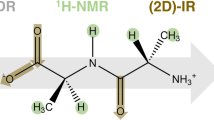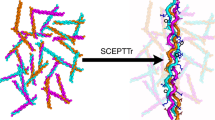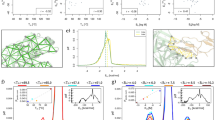Abstract
The noncovalent forces that stabilize protein structures are not fully understood. One way to address this is to study equilibria between unfolded states and α-helices in peptides. Electrostatic forces—which include interactions between side chains, the backbone and side chains, and side chains and the helix macrodipole—are believed to contribute to these equilibria. Here we probe these interactions experimentally using designed peptides. We find that both terminal backbone–side chain and certain side chain–side chain interactions (which include both local effects between proximal charges and interatomic contacts) contribute much more to helix stability than side chain–helix macrodipole electrostatics, which are believed to operate at larger distances. This has implications for current descriptions of helix stability, the understanding of protein folding and the refinement of force fields for biomolecular modeling and simulations. In addition, this study sheds light on the stability of rod-like structures formed by single α-helices, which are common in natural proteins such as non-muscle myosins.
This is a preview of subscription content, access via your institution
Access options
Subscribe to this journal
Receive 12 print issues and online access
$259.00 per year
only $21.58 per issue
Buy this article
- Purchase on Springer Link
- Instant access to full article PDF
Prices may be subject to local taxes which are calculated during checkout





Similar content being viewed by others
Change history
05 June 2015
In the version of this article initially published, two pairs of citations of Figures 4b and 4c were inadvertently switched. The errors have been corrected in the HTML and PDF versions of the article.
References
Dill, K.A. Dominant forces in protein folding. Biochemistry 29, 7133–7155 (1990).
Pauling, L., Corey, R.B. & Branson, H.R. The structure of proteins: two hydrogen-bonded helical configurations of the polypeptide chain. Proc. Natl. Acad. Sci. USA 37, 205–211 (1951).
Bartlett, G.J., Choudhary, A., Raines, R.T. & Woolfson, D.N. n→π* interactions in proteins. Nat. Chem. Biol. 6, 615–620 (2010).
Bartlett, G.J., Newberry, R.W., VanVeller, B., Raines, R.T. & Woolfson, D.N. Interplay of hydrogen bonds and n→π* interactions in proteins. J. Am. Chem. Soc. 135, 18682–18688 (2013).
Bierzynski, A., Kim, P.S. & Baldwin, R.L. A salt bridge stabilizes the helix formed by isolated C-peptide of RNase-A. Proc. Natl. Acad. Sci. USA 79, 2470–2474 (1982).
Kim, P.S. & Baldwin, R.L. A helix stop signal in the isolated S-peptide of ribonuclease-A. Nature 307, 329–334 (1984).
Marqusee, S. & Baldwin, R.L. Helix stabilization by Glu−···Lys+ salt bridges in short peptides of de novo design. Proc. Natl. Acad. Sci. USA 84, 8898–8902 (1987).
Richardson, J.S. & Richardson, D.C. Amino acid preferences for specific locations at the ends of α-helices. Science 240, 1648–1652 (1988).
Doig, A.J. & Baldwin, R.L. N- and C-capping preferences for all 20 amino acids in α-helical peptides. Protein Sci. 4, 1325–1336 (1995).
Pace, C.N. & Scholtz, M.J. A helix propensity scale based on experimental studies of peptides and proteins. Biophys. J. 75, 422–427 (1998).
Penel, S., Hughes, E. & Doig, A.J. Side-chain structures in the first turn of the α-helix. J. Mol. Biol. 287, 127–143 (1999).
Iqbalsyah, T.M. & Doig, A.J. Anticooperativity in a Glu−Lys−Glu salt bridge triplet in an isolated α-helical peptide. Biochemistry 44, 10449–10456 (2005).
Spek, E.J., Bui, A.H., Lu, M. & Kallenbach, N.R. Surface salt bridges stabilize the GCN4 leucine zipper. Protein Sci. 7, 2431–2437 (1998).
Mayne, L. et al. Stabilizing effect of a multiple salt bridge in a prenucleated peptide. J. Am. Chem. Soc. 120, 10643–10645 (1998).
Olson, C.A., Spek, E.J., Shi, Z.S., Vologodskii, A. & Kallenbach, N.R. Cooperative helix stabilization by complex Arg-Glu salt bridges. Proteins 44, 123–132 (2001).
Scholtz, J.M., Qian, H., Robbins, V.H. & Baldwin, R.L. The energetics of ion-pair and hydrogen-bonding interactions in a helical peptide. Biochemistry 32, 9668–9676 (1993).
Shoemaker, K.R., Kim, P.S., York, E.J., Stewart, J.M. & Baldwin, R.L. Tests of the helix dipole model for stabilization of α-helices. Nature 326, 563–567 (1987).
Armstrong, K.M. & Baldwin, R.L. Charged histidine affects α-helix stability at all positions in the helix by interacting with the backbone charges. Proc. Natl. Acad. Sci. USA 90, 11337–11340 (1993).
Wada, A. The α-helix as an electric macro-dipole. Adv. Biophys. 1–63 (1976).
Hol, W.G.J., van Duijnen, P.T. & Berendsen, H.J.C. The α-helix dipole and the properties of proteins. Nature 273, 443–446 (1978).
Chakrabarti, P. An assessment of the effect of the helix dipole in protein structures. Protein Eng. 7, 471–474 (1994).
Sun, D.P., Sauer, U., Nicholson, H. & Matthews, B.W. Contributions of engineered surface salt bridges to the stability of T4 lysozyme determined by directed mutagenesis. Biochemistry 30, 7142–7153 (1991).
Lumb, K.J. & Kim, P.S. Measurement of interhelical electrostatic interactions in the GCN4 leucine zipper. Science 268, 436–439 (1995).
Lavigne, P., Sönnichsen, F.D., Kay, C.M. & Hodges, K.J. Interhelical salt bridges, coiled-coil stability, and specificity of dimerization. Science 271, 1136–1138 (1996).
Aqvist, J., Luecke, H., Quiocho, F.A. & Warshel, A. Dipoles localized at helix termini of proteins stabilize charges. Proc. Natl. Acad. Sci. USA 88, 2026–2030 (1991).
Wang, C.L. et al. A long helix from the central region of smooth muscle caldesmon. J. Biol. Chem. 266, 13958–13963 (1991).
Spink, B.J., Sivaramakrishnan, S., Lipfert, J., Doniach, S. & Spudich, J.A. Long single α-helical tail domains bridge the gap between structure and function of myosin VI. Nat. Struct. Mol. Biol. 15, 591–597 (2008).
Yang, Y. et al. A FERM domain autoregulates Drosophila myosin 7a activity. Proc. Natl. Acad. Sci. USA 106, 4189–4194 (2009).
Knight, P.J. et al. The predicted coiled-coil domain of myosin 10 forms a novel elongated domain that lengthens the head. J. Biol. Chem. 280, 34702–34708 (2005).
Peckham, M. & Knight, P.J. When a predicted coiled coil is really a single α-helix, in myosins and other proteins. Soft Matter 5, 2493–2503 (2009).
Süveges, D., Gáspári, Z., Tóth, G. & Nyitray, L. Charged single α-helix: A versatile protein structural motif. Proteins, Structure, Function, and Bioinformatics 74, 905–916 (2009).
Gáspári, Z., Suveges, D., Perczel, A., Nyitray, L. & Toth, G. Charged single alpha-helices in proteomes revealed by a consensus prediction approach. Biochim. Biophys. Acta 1824, 637–646 (2012).
Peckham, M. Coiled coils and SAH domains in cytoskeletal molecular motors. Biochem. Soc. Trans. 39, 1142–1148 (2011).
Sivaramakrishnan, S., Spink, B.J., Sim, A.Y.L., Doniach, S. & Spudich, J.A. Dynamic charge interactions create surprising rigidity in the ER/K α-helical protein motif. Proc. Natl. Acad. Sci. USA 105, 13356–13361 (2008).
Lyu, P.C.C., Gans, P.J. & Kallenbach, N.R. Energetic contribution of solvent-exposed ion-pairs to α-helix structure. J. Mol. Biol. 223, 343–350 (1992).
Cochran, D.A.E., Penel, S. & Doig, A.J. Effect of the N1 residue on the stability of the α-helix for all 20 amino acids. Protein Sci. 10, 463–470 (2001).
Cochran, D.A.E. & Doig, A.J. Effect of the N2 residue on the stability of the α-helix for all 20 amino acids. Protein Sci. 10, 1305–1311 (2001).
Iqbalsyah, T.M. & Doig, A.J. Effect of the N3 residue on the stability of the α-helix. Protein Sci. 13, 32–39 (2004).
Walter, S., Hubner, B., Hahn, U. & Schmid, F.X. Destabilization of a protein helix by electrostatic interactions. J. Mol. Biol. 252, 133–143 (1995).
Scholtz, J.M. et al. Calorimetric determination of the enthalpy change for the α-helix to coil transition of an alanine peptide in water. Proc. Natl. Acad. Sci. USA 88, 2854–2858 (1991).
Fernández-Recio, J. & Sancho, J. Intrahelical side chain interactions in α-helices: poor correlation between energetics and frequency. FEBS Lett. 429, 99–103 (1998).
de Sousa, M.M. et al. Amino acid pair- and triplet-wise groupings in the interior of α-helical segments in proteins. J. Theor. Biol. 271, 136–144 (2011).
Berman, H.M. et al. The Protein Data Bank. Nucleic Acids Res. 28, 235–242 (2000).
McDonald, I.K. & Thornton, J.M. Satisfying hydrogen-bonding potential in proteins. J. Mol. Biol. 238, 777–793 (1994).
Lacroix, E., Viguera, A.R. & Serrano, L. Elucidating the folding problem of α-helices: local motifs, long-range electrostatics, ionic-strength dependence and prediction of NMR parameters. J. Mol. Biol. 284, 173–191 (1998).
Sivaramakrishnan, S. & Spudich, J.A. Systematic control of protein interaction using a modular ER/K α-helix linker. Proc. Natl. Acad. Sci. USA 108, 20467–20472 (2011).
Baboolal, T.G. et al. The SAH domain extends the functional length of the myosin lever. Proc. Natl. Acad. Sci. USA 106, 22193–22198 (2009).
Scholtz, J.M., Qian, H., York, E.J., Stewart, J.M. & Baldwin, R.L. Parameters of helix-coil transition theory for alanine-based peptides of varying chain lengths in water. Biopolymers 31, 1463–1470 (1991).
Myers, J.K., Pace, C.N. & Scholtz, J.M. A direct comparison of helix propensity in proteins and peptides. Proc. Natl. Acad. Sci. USA 94, 2833–2837 (1997).
Greenfield, N.J. Using circular dichroism collected as a function of temperature to determine the thermodynamics of protein unfolding and binding interactions. Nat. Protoc. 1, 2527–2535 (2006).
Gorbet, G. et al. A parametrically constrained optimization method for fitting sedimentation velocity experiments. Biophys. J. 106, 1741–1750 (2014).
Kjaergaard, M., Brander, S. & Poulsen, F.M. Random coil chemical shift for intrinsically disordered proteins: effects of temperature and pH. J. Biomol. NMR 49, 139–149 (2011).
Kjaergaard, M. & Poulsen, F.M. Sequence correction of random coil chemical shifts: correlation between neighbor correction factors and changes in the Ramachandran distribution. J. Biomol. NMR 50, 157–165 (2011).
Wang, G. & Dunbrack, R.L. PISCES: a protein sequence culling server. Bioinformatics 19, 1589–1591 (2003).
Hutchinson, E.G. & Thornton, J.M. PROMOTIF—A program to identify and analyze structural motifs in proteins. Protein Sci. 5, 212–220 (1996).
Kabsch, W. & Sander, C. Dictionary of protein secondary structure: Pattern recognition of hydrogen-bonded and geometrical features. Biopolymers 22, 2577–2637 (1983).
Thomas, A., Milon, A. & Brasseur, R. Partial atomic charges of amino acids in proteins. Proteins, Structure, Function, and Bioinformatics 56, 102–109 (2004).
Acknowledgements
D.N.W. would like to dedicate this paper to the memory of Prof. Dudley H. William FRS, an inspirational scientist, mentor and person. We are grateful to the Engineering and Physical Sciences Research Council (EPSRC) of the UK for a studentship to E.G.B. and the EPSRC/National Science Foundation (EP/J001430) for a grant to D.N.W. that funded G.J.B. D.N.W. holds a Royal Society Wolfson Research Merit Award. We thank C. Wood for a script to align helical axes; M. Peckham and A. Mulholland, and members of the Woolfson and Faul groups, for helpful discussions; and S. Whittaker and the Henry Wellcome Building NMR facility at the University of Birmingham for access to the Wellcome Trust–funded 900 MHz spectrometer.
Author information
Authors and Affiliations
Contributions
E.G.B., C.F.J.F. and D.N.W. designed the research; E.G.B. made the synthetic peptides and performed the CD spectroscopy; M.P.C. and E.G.B. collected and analyzed the NMR data; G.J.B., E.G.B. and D.N.W. performed the bioinformatics; E.G.B. and R.B.S. constructed and analyzed atomistic models for the peptides; N.L. performed and analyzed the helix-dipole calculations; E.G.B., G.J.B. and D.N.W. wrote the paper. All authors reviewed and contributed to the manuscript.
Corresponding author
Ethics declarations
Competing interests
The authors declare no competing financial interests.
Supplementary information
Supplementary Text and Figures
Supplementary Results, Supplementary Figures 1–43 and Supplementary Tables 1–9. (PDF 6678 kb)
Rights and permissions
About this article
Cite this article
Baker, E., Bartlett, G., Crump, M. et al. Local and macroscopic electrostatic interactions in single α-helices. Nat Chem Biol 11, 221–228 (2015). https://doi.org/10.1038/nchembio.1739
Received:
Accepted:
Published:
Issue Date:
DOI: https://doi.org/10.1038/nchembio.1739
This article is cited by
-
Engineering protein stability with atomic precision in a monomeric miniprotein
Nature Chemical Biology (2017)
-
Characterization of long and stable de novo single alpha-helix domains provides novel insight into their stability
Scientific Reports (2017)
-
A closer look into the α-helix basin
Scientific Reports (2016)
-
Erratum: Corrigendum: Local and macroscopic electrostatic interactions in single α-helices
Nature Chemical Biology (2015)
-
Inversion of Supramolecular Chirality by Sonication-Induced Organogelation
Scientific Reports (2015)



